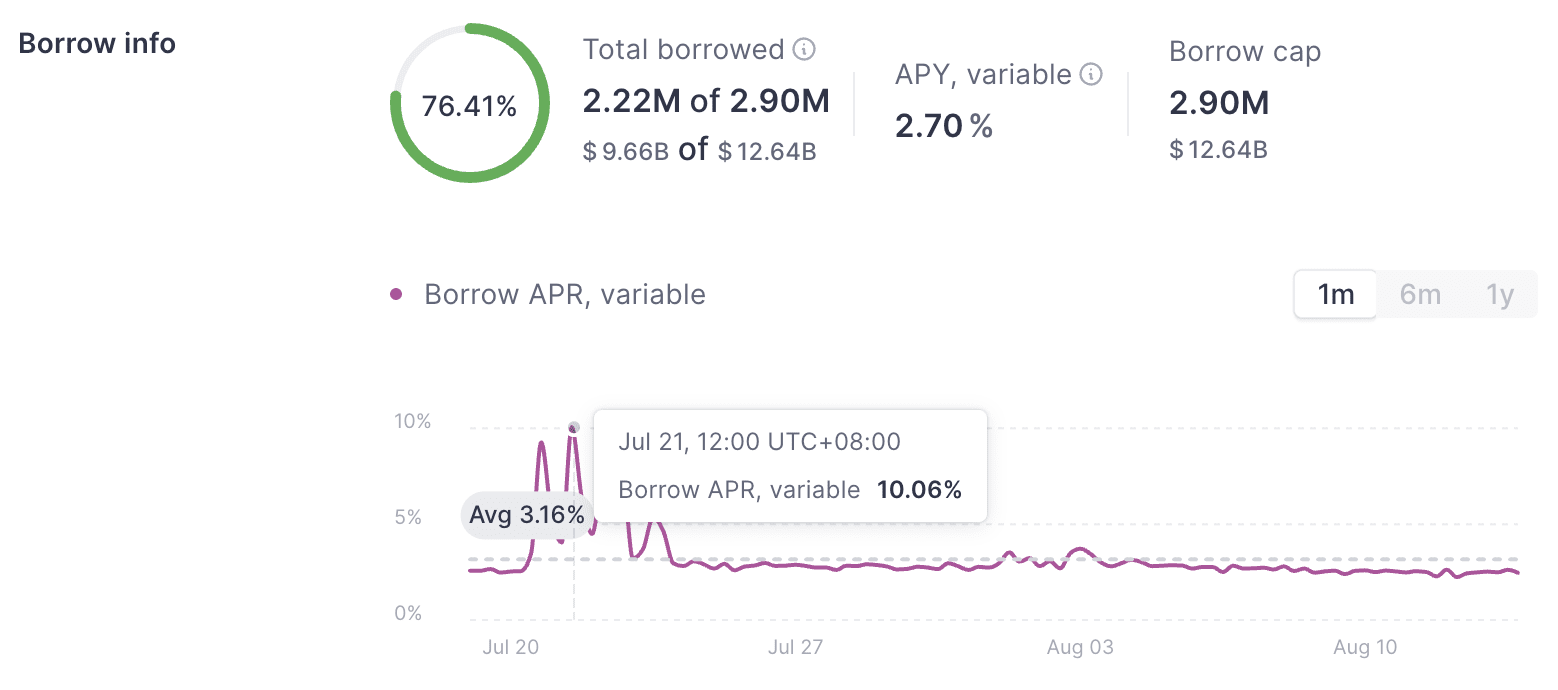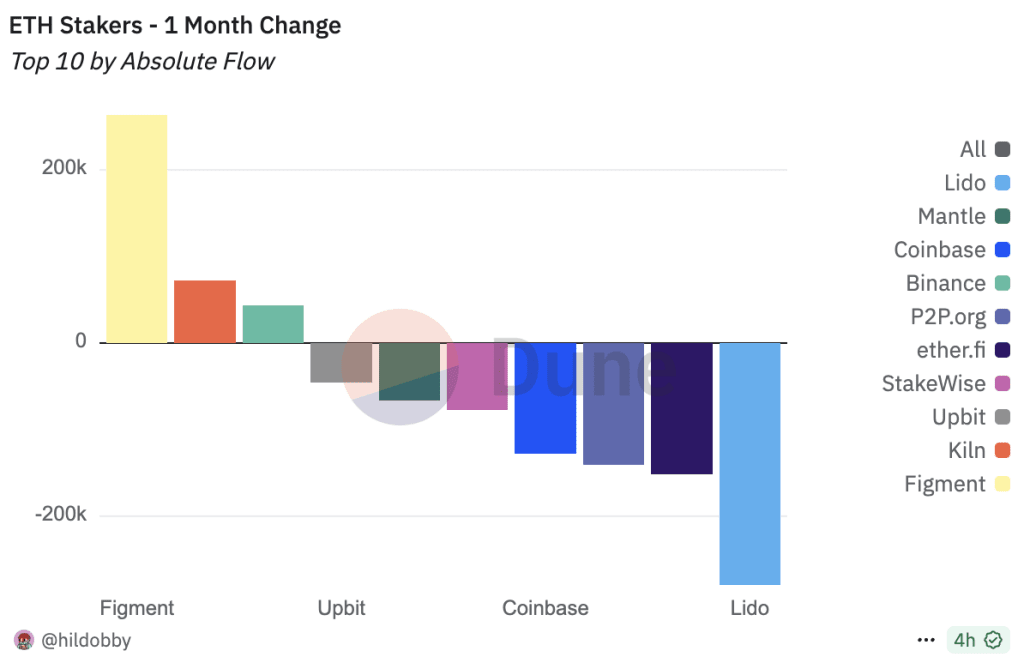Why has Ethereum triggered a 'unlocking wave'?
As of mid-August 2025, the amount of Ethereum (ETH) queued for unstaking has skyrocketed to over 870,000 ETH, with a total value exceeding $3.8 billion, setting a record since the Celsius withdrawal incident in January 2024. This wave of large-scale unlocking behavior has attracted significant market attention, raising questions of whether it is profit-taking or a shift by institutions. This article will dissect the six key factors behind it and the potential impacts on ETH prices and market momentum.
Borrowing rates skyrocketed, rendering ETH leveraged strategies ineffective.
In mid-July, borrowing rates for ETH on decentralized finance (DeFi) platforms like Aave surged from 2–3% to 10%, directly causing the popular leveraged staking (looping staking) strategy to lose its appeal. This strategy originally borrowed ETH against staked LST (liquid staking tokens) or LRT (liquid re-staking tokens) as collateral and reinvested it to amplify returns. However, when borrowing costs exceeded staking yields (a negative yield spread of -2.25% was observed in the week of July 21), many traders opted to exit early, unstake, and repay their loans, exacerbating the queue of validators exiting.
Notably, HTX exchange-related wallets have withdrawn over 167,000 ETH from Aave since June 18, significantly impacting market supply.
 Image source: (Chain News)
Image source: (Chain News)
LST and LRT prices decoupling, arbitrage opportunities surge.
As leveraged strategies are forced to unwind, liquid staking tokens such as stETH have begun to show a decoupling phenomenon from ETH prices, trading below their actual ETH value. Since unstaking must go through Ethereum's queuing mechanism, liquidity has tightened, leading some traders to choose to sell LST/LRT or engage in arbitrage: buying decoupled tokens at low prices and waiting to unlock and withdraw complete ETH.
For example, EtherFi's liquidity strategy single platform has accumulated about 20,000 ETH withdrawal applications. Other major platforms such as Lido (285,000 ETH), EtherFi (134,000 ETH), and Coinbase (113,000 ETH) are also leading the unstaking wave.
 Image source: (Chain News)
Image source: (Chain News)
Ethereum doubles, validators lock in profits.
Since April 2024, the price of ETH has surged over 160%, reaching a historic high of $4,878. In light of such an increase, many validators have chosen to unstake and secure profits at this time. As of August 16, 2025, the total amount queued for unstaking has reached 855,158 ETH (approximately $3.7 billion) and further increased to 877,106 ETH ($3.88 billion) within a few days, indicating a growing sentiment of profit-taking in the market.
Institutional strategy adjustments do not equate to selling.
Partial staking is not necessarily for selling, but for capital reallocation. For example, transferring ETH to higher-yielding DeFi protocols, switching to other validator operators, or consolidating nodes to improve efficiency. This wave of strategic adjustments has also attracted institutional attention: companies like SharpLink Gaming and Bitmine Technologies have increased their holdings of ETH, with 23 institutions collectively buying more than 681,103 ETH (worth $2.57 billion) since July, indicating that the market still holds long-term confidence in ETH.
Preparing for ETH staking ETFs.
Investors expect that the U.S. Securities and Exchange Commission (SEC) will approve ETH staking ETFs as early as October 2025. This may prompt some validators to unstake early and switch to more compliant and transparent staking products. For institutions and individual investors hoping to invest in ETH through traditional financial channels, ETFs will be an important entry point.
Network design limits cause queue congestion.
Ethereum's PoS (Proof of Stake) mechanism limits the number of validators allowed to exit to 8–10 per epoch (approximately 6.4 minutes) to ensure network stability. Therefore, once the demand for unstaking surges, waiting times will dramatically increase. As of mid-August 2025, the waiting time for exit has reached 15 days, a new high for this year, second only to the six-day queue triggered by Celsius's unstaking of 550,000 ETH in January 2024.
Despite concerns about selling pressure, market liquidity remains strong.
Although a large amount of ETH awaiting unstaking may create selling pressure, market performance remains relatively stable. ETFs continue to experience daily inflows of up to $400 million to $1 billion, with a net inflow of $160 million in July, and only one instance of a $500 million outflow occurred on August 5.
On the other hand, the demand for ETH staking remains strong, with over 450,000 ETH entering the validator queue on a single day since June, even surpassing the amount being unstaked. According to the latest data, approximately 29.5% of circulating ETH (around 35.3 million to 35.7 million) is currently staked, indicating that the overall network is still operating healthily.
ETH price outlook: Survive 4200 and aim for 5000?
ETH is currently trading at around $4,500, down 7% from its 2025 peak. From a technical perspective, $4,200 is a key support level; if broken, it may test the range of $3,900 to $4,100. However, if ETF funds continue to flow in, it is expected to rise between $5,000 and $5,200.
Notably, on August 6, a negative buy-sell gap of 116,000 ETH was recorded in a single day (net selling pressure of $418 million), the second highest in history. However, corporate treasuries currently hold a total of 966,000 ETH, an eightfold increase since the beginning of the year, reflecting that long-term investors still have confidence in ETH's prospects.
This article is authorized for reprint from: (Chain News)
Original title: (Ethereum unlocking queue hits a new high! Over $3.8 billion awaiting withdrawal, understand the reasons behind it all at once)
Original author: Elponcho
This article titled 'The Ethereum unlocking wave is coming, six factors explain why 870,000 ETH are queued for exit' was first published in 'Crypto City'.

